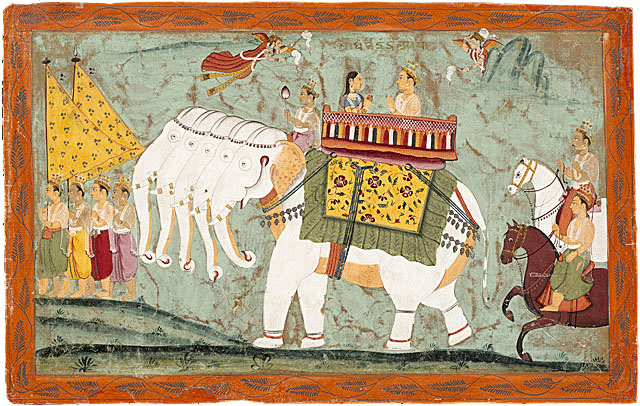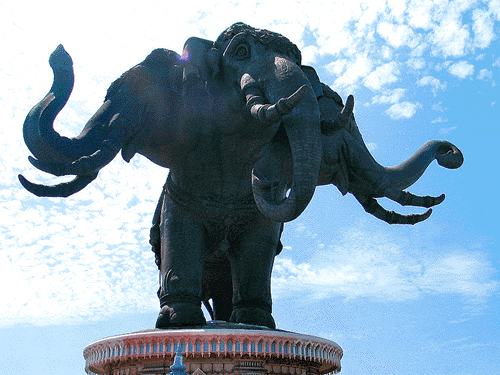Sri Airavata
BY: SUN STAFF

Lord Indra (Sakra) and Sachi riding the five-headed Divine Elephant, Airavata
Folio from Panchakalyanaka (Five Auspicious Events in the Life of Jina Rishabhanatha [Jain]
Amber, Rajasthan, c. 1670
Mar 20, CANADA (SUN) — Lord Indra's white elephant vahana.
Airavata is the white elephant who carries Lord Indra. According to the Ramayana, Airavata's mother was Iravati, the daughter of Kadru and granddaughter of Kasyapa. According to the Matangalila, Airavata was born when Lord Brahma sang sacred hymns over the halves of the egg shell from which Garuda hatched. He was followed at birth by seven more male and eight female elephants.
Abharamu is the elephant wife of Airavata, who has four tusks and seven trunks, and is spotless white. Prithu eventually made Airavata the King of all elephants.
The eight guardian deities who preside over the eight points of the compass each sits on an elephant vahana. They are: Kubera (north), Yama (south), Indra (east), Varuna (west), Isana (northeast), Agni (southeast), Vayu (northwest), and Nirrti/raksasa (southwest). Each of these elephant take part in the defense and protection of its respective quarter. Chief among them is Airavata of Indra. Airavata also stands at the entrance to Svarga, Indra's palace.
Airavata is also known as 'Ardha-Matanga', meaning "elephant of the clouds", and 'Naga-malla', meaning "the fighting elephant". He is also called 'Arkasodara', meaning "brother of the sun", and yet another of his names means "the one who knits or binds the clouds".
Elephants are known to be capable of producing clouds. The connection of elephants with water and rain is emphasized in the pastimes of Indra, who rides Airavata when he defeats Vritra. The mighty elephant reaches down his trunk into the watery underworld, sucks up water, then sprays it into the clouds, which Indra then causes to rain forth cool water. Therefore, Airavata is linking the waters of the sky with those of the underworld.
In the Bhagavad-gita, Lord Krsna says, "Of horses, know Me to be the nectar-born Ucchaisravas; of lordly elephants, Airavata and of men, the monarch." (10.27)
Airavatesvara Temple

Airavateshwarar Gopuram
At Darasuram near Kumbakonam, in the South Indian state of Tamil Nadu, is a temple where it is believed that Airavata worshipped the Shiva-lingam, which was thereafter named Airavateswara. This Airateswara temple, which is rich in rare Dravidian sculpture and architectural workmanship, was built by Rajaraja Chola II (1146-73).
Lord Shiva is here known as Airavateshwara, because he was worshipped at this temple by Airavata. Airavata, while suffering from a change of colour due to a curse from Sage Durvasa, had his colours restored by bathing in the sacred waters of this temple. In commemoration of the pastime, an image of Airavata with a seated Indra is found in an inner shrine.
It is said that the King of Death, Yama, also worshipped Shiva here. Yama, who was also suffering under a Rishi's curse, had a burning sensation all over the body, was cured by the presiding deity Airavateswarar. Yama took bath in the sacred tank and got rid of the burning sensation, and since then, the tank has been known as Yamateertham.
Erawan

Erawan statue at Erawan Museum in Samut Prakan Province, Thailand
Erawan is the name Airavata is known by in Thailand. There, he is depicted as a huge elephant having three, and sometimes with 33 heads. The heads are often shown with more than two tusks. Some statues show Lord Indra riding on Erawan.
Erawan is sometimes associated with the old Lao Kingdom of Lan Xang and the defunct Kingdom of Laos. Their society pictured Erawan, more commonly known there as "The three headed elephant" on their Royal Flag.[1]
References:
1. Frank E. Reynolds (Transl.): Three Worlds According To King Ruang: A Thai Buddhist Cosmology. Berkeley 1982

The Sun
News
Editorials
Features
Sun Blogs
Classifieds
Events
Recipes
PodCasts
About
Submit an Article
Contact Us
Advertise
HareKrsna.com
Copyright 2005, HareKrsna.com. All rights reserved.
